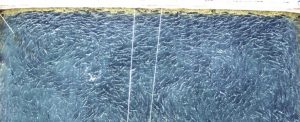Sockeye Disease – Infectious hematopoietic necrosis (IHN)
IHN is a disease of wild Pacific salmon that targets, in particular, sockeye salmon. Atlantic farmed salmon are also highly susceptible to this virus. Once it penetrates a farm, IHN can spread many kilometers from farm to farm.
In 2002, farmed Atlantic salmon infected with IHN virus were accidentally transported by boat into Musgamagw Dzawada’enuxw Territory. An outbreak spread from one farm to another and was also carried through industry vessels to other regions of the BC coast.
The virus infected 32 salmon farms across southern BC and lasted three years. Government scientist Dr. Kyle Garver testified at the Cohen Commission that during an IHN outbreak each salmon farm could shed 65-billion infectious viral particles per hour. While IHN is natural to BC, wild salmon swimming past the infected farms were exposed to extremely high levels of virus. For humans, this would be like having a person with the flu sneeze repeatedly in your face.
More recently, an IHN vaccine was developed and is administered to farm salmon before they enter the ocean pens. The farm salmon, however, remained infectious spreading the virus over a 30-kilometre distance.
Some salmon farm viruses may be local but when large numbers of farm salmon are infected this poses a very big threat to passing wild salmon. Unfortunately, salmon farms are located on nearly every wild salmon migration route in BC. This is a recipe for disaster.

